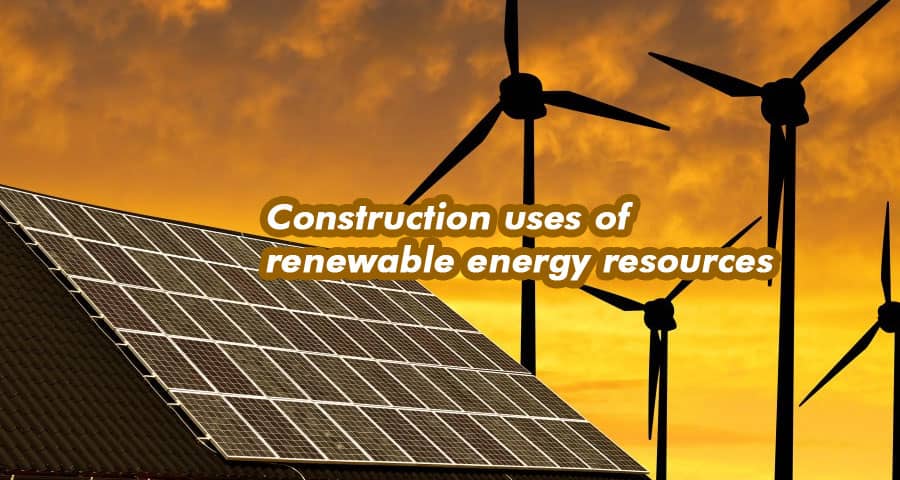Leveraging Renewable Energy Resources for Sustainable Construction

In the contemporary landscape of construction, the utilization of renewable energy resources has emerged as a pivotal cornerstone in fostering sustainability and mitigating environmental impact. As we embark on a journey towards a greener future, construction industries worldwide are increasingly integrating renewable energy solutions into their frameworks, revolutionizing the very essence of building practices.
Understanding Renewable Energy in Construction
Solar Power: Illuminating Pathways to Sustainability
One of the most prominent renewable energy sources, solar power epitomizes innovation in construction. By harnessing the boundless energy emitted by the sun, solar panels transform sunlight into electricity, offering an eco-friendly alternative to traditional power sources. In construction, solar panels are seamlessly integrated into building designs, adorning rooftops and facades, thus maximizing energy efficiency while minimizing carbon footprint.
Wind Energy: Harnessing Nature's Breeze
In the realm of sustainable construction, wind energy stands as a beacon of promise. Through the deployment of wind turbines, construction endeavors can tap into the inexhaustible power of the wind, generating clean and renewable electricity. From towering turbines on expansive landscapes to sleek, urban installations, the versatility of wind energy in construction knows no bounds, offering a viable solution for powering both residential and commercial structures.
Geothermal Systems: Delving into Earth's Depths
Beneath the surface lies a wellspring of untapped potential, waiting to be harnessed for the betterment of construction practices. Geothermal energy systems delve into the depths of the earth, extracting heat to provide sustainable heating and cooling solutions for buildings. By leveraging the Earth's natural thermal properties, geothermal systems offer a renewable alternative to conventional HVAC systems, significantly reducing energy consumption and emissions.
Advantages of Integrating Renewable Energy in Construction
Environmental Sustainability: Paving the Way for a Greener Tomorrow
The integration of renewable energy resources in construction serves as a testament to our commitment to environmental stewardship. By reducing reliance on fossil fuels and mitigating greenhouse gas emissions, sustainable construction practices pave the way for a greener, more sustainable future. From reducing air and water pollution to conserving natural resources, the environmental benefits of renewable energy integration are manifold, transcending generations and leaving a lasting legacy of preservation.
Cost-Efficiency: Driving Economic Viability
Beyond its environmental merits, renewable energy integration in construction yields significant cost savings over the long term. While initial investment costs may be higher than conventional methods, the operational and maintenance expenses associated with renewable energy systems are substantially lower, translating into substantial savings over the lifespan of a building. Moreover, with advancements in technology and economies of scale, the cost of renewable energy components continues to decline, further bolstering the economic viability of sustainable construction practices.
Resilience and Reliability: Ensuring Long-Term Stability
In an era characterized by climate volatility and energy uncertainty, the resilience and reliability offered by renewable energy resources are unparalleled. Unlike finite fossil fuels, renewable energy sources such as solar, wind, and geothermal are inherently abundant and renewable, ensuring a consistent and reliable energy supply for construction projects. Moreover, decentralization of energy production through distributed generation enhances grid resilience, mitigating the risks associated with centralized power systems and reducing vulnerability to disruptions.
Embracing a Sustainable Future Through Renewable Energy
As we stand at the precipice of a sustainable revolution, the integration of renewable energy resources in construction represents a paradigm shift in our approach to building. By harnessing the power of the sun, wind, and earth, we can create buildings that not only stand the test of time but also contribute to a healthier, more sustainable planet. From reducing carbon emissions to fostering energy independence, the benefits of renewable energy integration are manifold, underscoring its indispensable role in shaping the future of construction.
In conclusion, the construction industry stands poised at a pivotal juncture, where sustainability and innovation converge to redefine the very essence of building practices. Through the strategic integration of renewable energy resources, we can transcend the limitations of the past and usher in a new era of sustainable development. Together, let us embrace the power of renewable energy and pave the way for a brighter, more sustainable future for generations to come.
